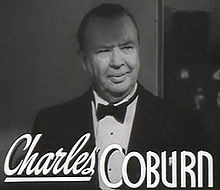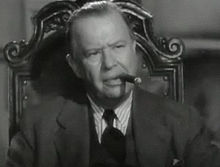Charles Coburn
Charles Coburn | |
|---|---|
 Coburn from a trailer for Rhapsody in Blue (1945) | |
| Born | June 19, 1877 |
| Died | August 30, 1961 (aged 84) New York City, New York, U.S. |
| Resting place | Bonaventure Cemetery |
| Occupation | Actor |
| Years active | 1901–1960 |
| Spouse(s) | Winifred Natzka
(m. 1959; |
| Children | 7 |
Charles Douville Coburn (June 19, 1877 – August 30, 1961) was an American actor.[1] He was nominated for a Best Supporting Actor Academy Award three times – in The Devil and Miss Jones (1941), The More the Merrier (1943), and The Green Years (1946) – winning for his performance in The More the Merrier. He was honored with a star on the Hollywood Walk of Fame in 1960 for his contribution to the film industry.
Biography[]

Coburn was born in Macon, Georgia,[2] the son of Scotch-Irish Americans Emma Louise Sprigman (May 11, 1838 Springfield, Ohio – November 12, 1896 Savannah, Georgia) and Moses Douville Coburn (April 27, 1834 Savannah, Georgia – December 27, 1902 Savannah, Georgia). Growing up in Savannah, he started out at age 14 doing odd jobs at the local Savannah Theater, handing out programs, ushering, or being the doorman. By age 17 or 18, he was the theater manager.[2][3] He later became an actor, making his debut on Broadway in 1901. Coburn formed an acting company with actress Ivah Wills in 1905.[2][3] They married in 1906. In addition to managing the company, the couple performed frequently on Broadway.
After his wife's death in 1937, Coburn relocated to Los Angeles, California and began film work. He won an Academy Award for Best Supporting Actor for his role as a retired millionaire playing Cupid in The More the Merrier in 1943. He was also nominated for The Devil and Miss Jones in 1941 and The Green Years in 1946. Other notable film credits include Of Human Hearts (1938), The Lady Eve (1941), Kings Row (1942), The Constant Nymph (1943), Heaven Can Wait (1943), Wilson (1944), Impact (1949), The Paradine Case (1947), Everybody Does It (1950), Has Anybody Seen My Gal? (1952), Monkey Business (1952), Gentlemen Prefer Blondes (1953), and John Paul Jones (1959). He usually played comedic parts, but his roles in Kings Row and Wilson showed his dramatic versatility.
For his contributions to motion pictures, in 1960, Coburn was honored with a star on the Hollywood Walk of Fame at 6268 Hollywood Boulevard.
Political activity[]

In the 1940s, Coburn served as vice-president of the Motion Picture Alliance for the Preservation of American Ideals, a group opposed to leftist infiltration and proselytization in Hollywood during the Cold War.[4] Born and raised in the southern state of Georgia, Coburn was a member of the White Citizens' Councils, a white supremacist group which opposed racial integration.[5][6]
A staunch Republican, Coburn supported Thomas Dewey in the 1944 United States presidential election.[7]
Personal life[]
Coburn married Ivah Wills (born August 19, 1878) on January 29, 1906 in Atlanta, Georgia. They had six children.[8] Ivah died on December 3, 1937 in New York City of congestive heart failure, aged 59.[citation needed] The 82 year-old Coburn married Winifred Natzka on June 30, 1959 in Los Angeles. She was the widow of the New Zealand bass opera singer Oscar Natzka. They had one child,[8] a daughter.
Coburn died of a heart attack on August 30, 1961, at age 84 in New York City. Winifred moved to New Zealand.
Complete filmography[]
- Boss Tweed (1933 short) as Boss Tweed
- The People's Enemy (1935) as Judge Hays
- Of Human Hearts (1938) as Dr. Charles Shingle
- Vivacious Lady (1938) as Mr. Morgan
- Yellow Jack (1938) as Dr. Finlay
- Lord Jeff (1938) as Captain Briggs
- Idiot's Delight (1939) as Dr. Hugo Waldersee
- Made for Each Other (1939) as Judge Joseph M. Doolittle
- The Story of Alexander Graham Bell (1939) as Gardner Hubbard
- Bachelor Mother (1939) as J. B. Merlin
- Stanley and Livingstone (1939) as Lord Tyce
- In Name Only (1939) as Mr. Walker
- Road to Singapore (1940) as Joshua Mallon IV
- Edison, the Man (1940) as General Powell
- Florian (1940) as Dr. Johannes Hofer
- The Captain Is a Lady (1940) as Captain Abe Peabody
- Three Faces West (1940) as Dr. Karl Braun
- The Lady Eve (1941) as 'Colonel' Harrington
- The Devil and Miss Jones (1941) as Merrick
- Our Wife (1941) as Professor Drake
- Unexpected Uncle (1941) as Seton Mansley aka Alfred Crane
- H. M. Pulham, Esq. (1941) as Mr. Pulham Sr.
- Kings Row (1942) as Dr. Henry Gordon
- In This Our Life (1942) as William Fitzroy
- George Washington Slept Here (1942) as Uncle Stanley J. Menninger
- Forever and a Day (1943) as Sir William (scenes cut)
- The More the Merrier (1943) as Benjamin Dingle
- The Constant Nymph (1943) as Charles Creighton
- Heaven Can Wait (1943) as Hugo Van Cleve
- Princess O'Rourke (1943) as Holman - Maria's Uncle
- My Kingdom for a Cook (1943) as Rudyard Morley
- Knickerbocker Holiday (1944) as Peter Stuyvesant
- Wilson (1944) as Professor Henry Holmes
- The Impatient Years (1944) as William Smith
- Together Again (1944) as Jonathan Crandall Sr
- A Royal Scandal (1945) as Chancellor Nicolai Iiyitch
- Rhapsody in Blue (1945) as Max Dreyfus
- Over 21 (1945) as Robert Drexel Gow
- Shady Lady (1945) as Col. John Appleby
- Colonel Effingham's Raid (1946) as Col. Will Seaborn Effingham
- The Green Years (1946) as Alexander Gow
- Lured (1947) as Inspector Harley Temple
- The Paradine Case (1947) as Sir Simon Flaquer
- B.F.'s Daughter (1948) as B.F. Fulton
- Green Grass of Wyoming (1948) as Beaver Greenway
- Impact (1949) as Lt. Tom Quincy
- Yes Sir That's My Baby (1949) as Professor Jason Hartley
- The Gal Who Took the West (1949) as Gen. Michael O'Hara
- The Doctor and the Girl (1949) as Dr. John Corday
- Everybody Does It (1949) as Major Blair
- Louisa (1950) as Abel Burnside
- Peggy (1950) as Professor 'Brooks' Brookfield
- Mr. Music (1950) as Alex Conway
- The Highwayman (1951) as Lord Walters
- Has Anybody Seen My Gal? (1952) as Samuel Fulton / John Smith
- Monkey Business (1952) as Mr. Oliver Oxley
- Trouble Along the Way (1953) as Father Burke
- Gentlemen Prefer Blondes (1953) as Sir Francis 'Piggy' Beekman
- The Rocket Man (1954) as Mayor Ed Johnson
- The Long Wait (1954) as Gardiner
- Country Doctor (1954 TV movie)
- How to Be Very, Very Popular (1955) as Dr. Tweed
- The Power and the Prize (1956) as Guy Eliot
- Around the World in 80 Days (1956) as a Hong Kong steamship company clerk
- Town on Trial (1957) as Dr. John Fenner
- How to Murder a Rich Uncle (1957) as Uncle George
- The Story of Mankind (1957) as Hippocrates
- The Remarkable Mr. Pennypacker (1959) as Grampa Pennypacker
- A Stranger in My Arms (1959) as Vance Beasley
- John Paul Jones (1959) as Benjamin Franklin
- Pepe (1960) as Himself
Radio appearances[]
| Year | Program | Episode/source |
|---|---|---|
| 1946 | Academy Award | The Devil and Miss Jones[9] |
See also[]
References[]
- ^ Obituary Variety, September 6, 1971.
- ^ Jump up to: a b c "Charles Coburn (1877–1961)". The New Georgia Encyclopedia.
- ^ Jump up to: a b "Charles Coburn Collection". University of Georgia Libraries – Hargrett Rare Book & Manuscript Library.
- ^ Doyle Greene, The American Worker on Film: A Critical History, 1909-1999 (Jefferson NC: MacFarland, 2010), 80-82. ISBN 9780786457762
- ^ "Archived copy". Archived from the original on 2016-03-04. Retrieved 2015-08-08.CS1 maint: archived copy as title (link)
- ^ "The Bend Bulletin from Bend, Oregon on June 13, 1959 · Page 5". Newspapers.com.
- ^ Critchlow, Donald T. (2013-10-21). When Hollywood Was Right: How Movie Stars, Studio Moguls, and Big Business Remade American Politics. ISBN 9781107650282.
- ^ Jump up to: a b "Oscar Profile #104: Charles Coburn". CinemaSight. 20 September 2012. Retrieved August 26, 2013.
- ^ "Charles Coburn Is 'Academy' Star". Harrisburg Telegraph. October 19, 1946. p. 17. Retrieved September 29, 2015 – via Newspapers.com.

Further reading[]
- Alistair, Rupert (2018). "Charles Coburn". The Name Below the Title : 65 Classic Movie Character Actors from Hollywood's Golden Age (softcover) (First ed.). Great Britain: Independently published. pp. 68–71. ISBN 978-1-7200-3837-5.
External links[]
| Wikimedia Commons has media related to Charles Coburn. |
- 1877 births
- 1961 deaths
- 20th-century American male actors
- Actors from Savannah, Georgia
- American male film actors
- American male stage actors
- American people of Scotch-Irish descent
- American white supremacists
- Best Supporting Actor Academy Award winners
- California Republicans
- Citizens' Councils
- Male actors from Georgia (U.S. state)
- Far-right politics in the United States